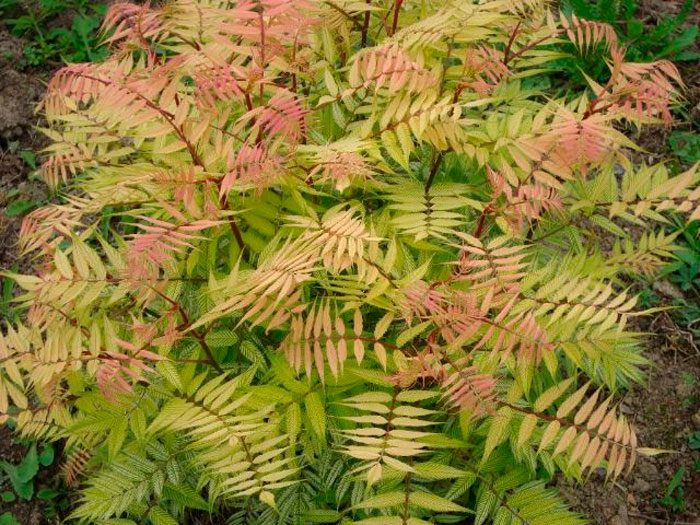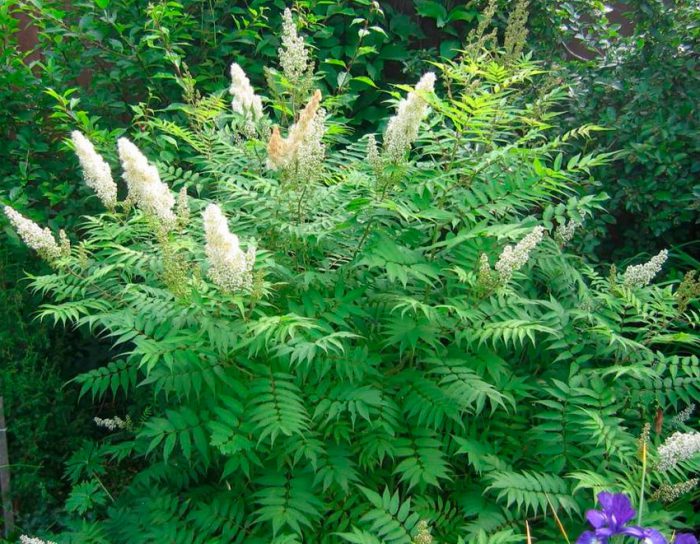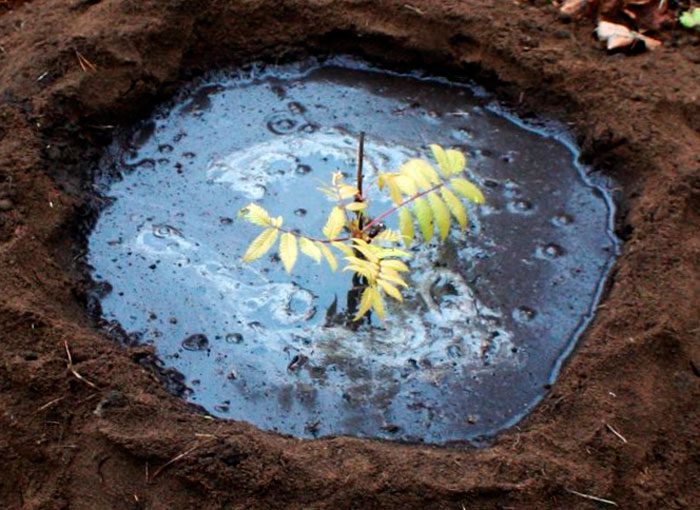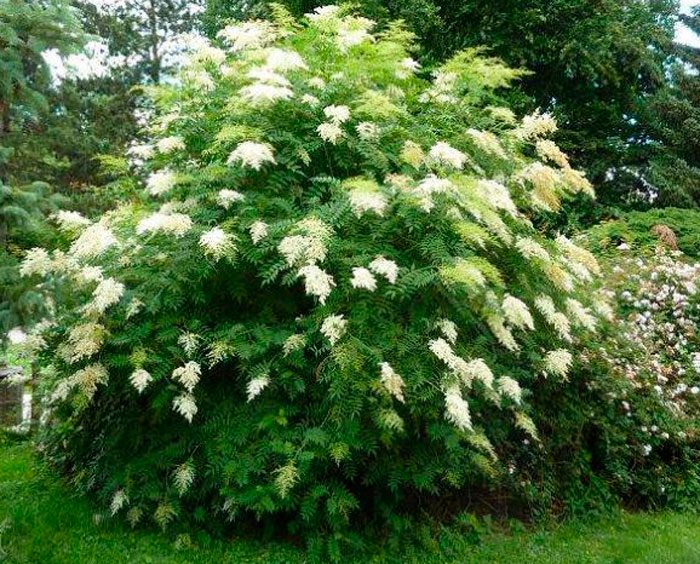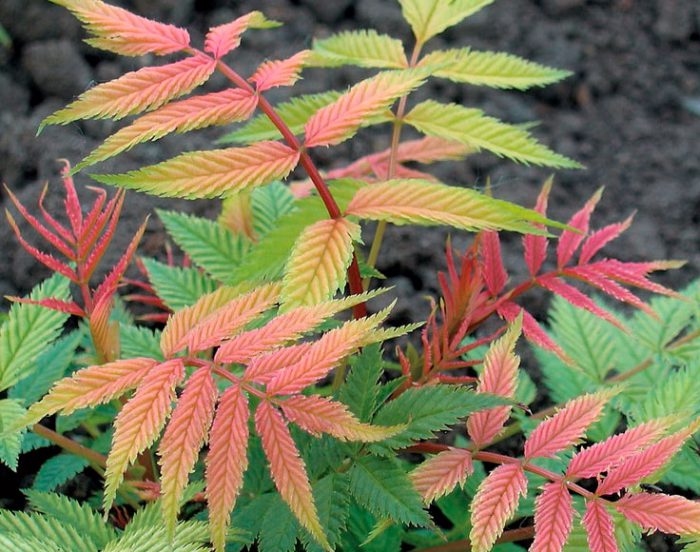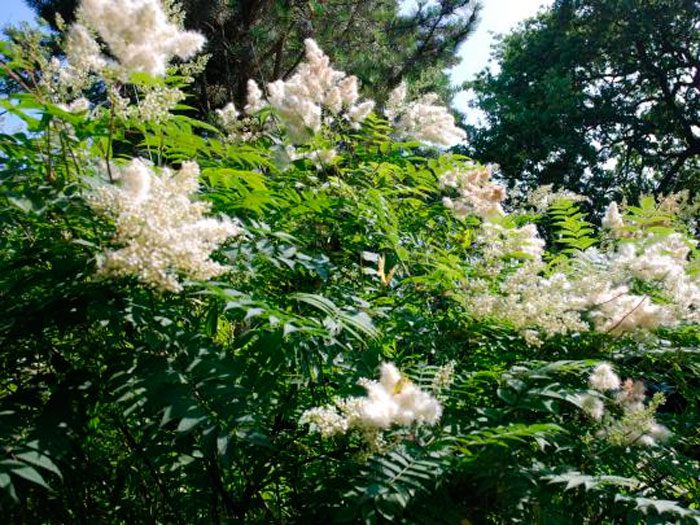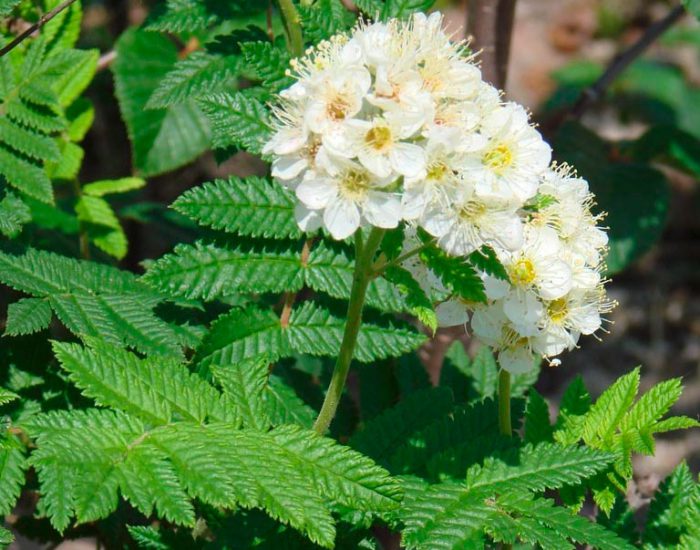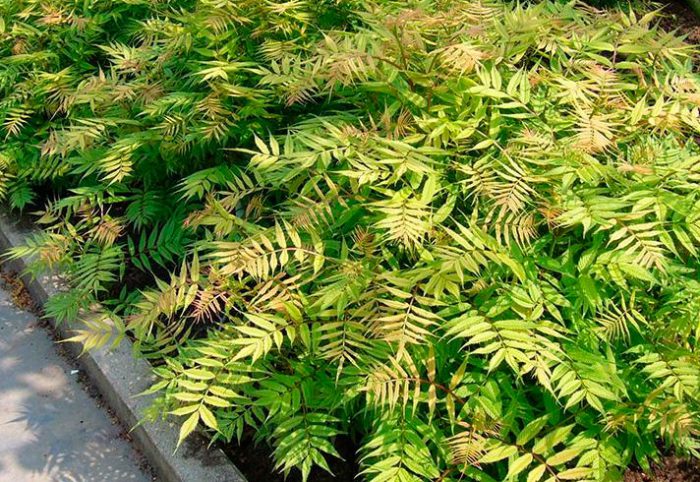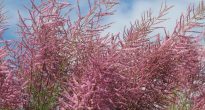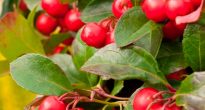Fieldfare (Sorbaria) is a member of the rose family. In nature, such plants are found in Asia. This genus unites only 10 species. The name of such a plant comes from the Latin word "Sorbus", which translates as "mountain ash". The fact is that the leaf plates of the representatives of this genus are very similar to the foliage of the mountain ash. As an ornamental plant, fieldfare has been cultivated since the middle of the 18th century.
Content
Features of fieldfare
Fieldfare is a deciduous shrub that can reach a height of about 3 meters. He can form very beautiful dense thickets, because he has many root shoots. Cranked-sinuous stems are colored gray-yellow. The composition of odd-pinnate complex leaf plates includes from 9 to 13 pairs of double-serrate or serrate leaves. The pyramidal panicle inflorescences consist of many small flowers of cream or white color. The fruit is a leaflet.
Such a shrub in landscape design is used to create group and single plantings, and it is also used for hedges, for decorating ponds, and also for strengthening the slopes.
Planting fieldfare in the open field
What time to plant
Fieldfare is planted in open soil in early spring, before sap flow begins or after leaf fall ends in autumn. This plant is relatively shade-loving, so it can be planted under tall trees. It feels equally well in very wet soil and in clayey dense soil.
How to plant
The size of the pit for planting should be approximately 0.7x0.7 m, while its depth should not be more than 0.5 m. If you are creating a group landing, then the distance between the specimens should be at least 100 centimeters. The fieldfare is similar to the blackthorn in that it can grow rapidly, capturing all new territories, therefore it is recommended to overlay the sides of the planting hole with slate or metal sheets. Make a good drainage layer at the bottom of the pit. It needs to be covered with a layer of soil mixture, consisting of soil combined with humus or compost. Then the root system of the seedling must be placed in the pit, and covered with soil combined with organic matter.During planting, make sure that the root collar of the plant rises above the surface of the site by 20-30 mm. The planted shrub must be watered, while 20 liters of water are poured under it. When the liquid is completely absorbed into the ground, the surface of the trunk circle will need to be covered with a layer of mulch.
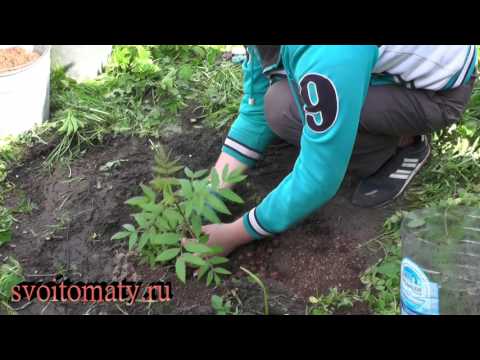

Watch this video on YouTube
Field care in the garden
Caring for fieldfare is quite simple, and even a beginner can handle it. Remember that the soil near the bush should always be slightly damp and loose. Provide him with timely removal of root shoots and weeds, and feed regularly (when grown in poor soil). Formative pruning is done only when necessary.
Watering should be plentiful, especially if there is a prolonged drought. Top dressing is carried out in small portions at least 2 times during the season, while nutrient mixtures are shallowly embedded or applied superficially. The shrubs are fed with compost, peat or humus, in some cases, complex mineral fertilizers are also used.
In order for the appearance of the plant to always remain as effective as possible, it is necessary to promptly cut off the inflorescences that have begun to fade. At the very beginning of the spring period, sanitary pruning is carried out, for this you need to cut out all injured, damaged by pests or disease, dried branches, as well as those that thicken the bush. If you do not thin the bush, the stems will become thinner, weaker, and they will age very quickly. Fieldfare tolerates pruning well, even rejuvenating. Remember to cut the root growth systematically.
Transfer
The bush tolerates transplantation very well. This procedure is very often performed together with the division of the bush. Preparing a new planting pit should be done in autumn or spring. At its bottom, a drainage layer should be placed, and a soil mixture should be prepared, consisting of soil removed from the pit, as well as compost or humus. Remove the bush from the ground, and, if necessary, cut it into several pieces, while taking into account that each delenka must have powerful shoots and well-developed roots. Places of cuts should be sprinkled with crushed charcoal, then the cuttings are planted in new places. If you do not divide the bush, then the dug out plant will need to be placed in a planting hole, which is filled with prepared soil mixture. The soil around the shrub is compacted, and then abundant watering is carried out.
Fieldfare propagation
Such a plant can be propagated by dividing the bush, this procedure is described in great detail above. Theoretically, fieldfare can be propagated by seeds, but in practice, seedlings appear very rarely. Most often, gardeners propagate this shrub with lignified cuttings and layering.
It is very simple and easy to propagate fieldberry by layering. In springtime, it will be necessary to choose a strong, healthy and long stem, and bend it to the surface of the site so that several buds are in contact with it. Then the stem is fixed in this position and covered with soil, while its top should remain free. Do not forget to water the cuttings in a timely manner in the summer. After a few weeks, the cuttings will take root, and in late summer or early autumn it can be cut off from the parent plant and planted in a new place.
Cuttings are cut from lignified stems, while the length of the apical segments can vary from 20 to 30 centimeters. For rooting, they are planted in a box filled with earth mixture. Keep the soil slightly moist at all times. If the cuttings root successfully, their tops should begin to grow.
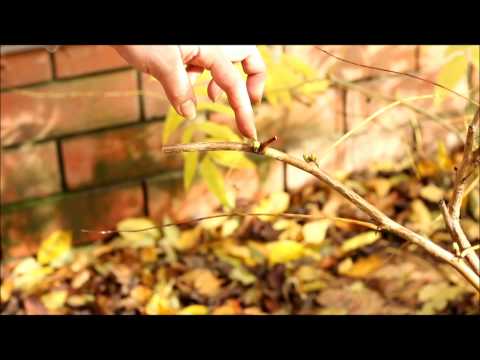

Watch this video on YouTube
Diseases and pests
Such a shrub has high phytoncidal properties, which explains its resistance to diseases and pests.Very rarely, green aphids or spider mites can settle on it. Such sucking insects suck out the plant sap from the bush, as a result it becomes lethargic, and the stems are deformed and the foliage turns yellow. In addition, there is a high probability that such pests will infect the fieldfare with a viral mosaic. Such a disease cannot be cured, and therefore all you have to do is dig up and destroy the plant. To get rid of such insects, they resort to treating the affected specimen with Fitoverm or Mitaka solution.
After flowering
When flowering is over, it will be necessary to cut off all wilting inflorescences. At the end of the leaf fall, the dried foliage must be collected and destroyed. The fieldfare is characterized by extremely high frost resistance, it is able to withstand even severe frosts without shelter.
Types and varieties of fieldfare with photos and names
Only 4 species of fieldfare are cultivated:
Felt field ash (Sorbaria tomentosa)
This species is native to East Asia. In height, such a plant can reach 6 meters. A shrub in nature prefers to grow on mountain slopes. It does not bloom. Possesses low cold resistance.
Field ashberry (Sorbaria arborea)
Found naturally in East Asia. The height of such a shrub does not exceed 6 meters. Such a slow-growing plant is highly frost-resistant. Blooming is observed in July – August.
Pallas fieldberry (Sorbaria pallasii)
This plant can be found in nature on the rocky slopes of Transbaikalia and the Far East. The height of this spectacular mountain ash does not exceed 1.2 m. The color of young stems is brown, they are glabrous or thinly pubescent with branched light yellow hairs. Old stems are covered with peeling bark. Unpaired linear-lanceolate leaf plates reach 15 centimeters in length, as a rule, on their surface there is pubescence, consisting of hairs of a red color. Not very large apical panicle inflorescences consist of white or cream flowers, the diameter of which is 1.5 cm. The fruit is a pubescent leaflet. Such a shrub is winter hardy.
Mountain ashberry (Sorbaria sorbifolia)
This type is most popular with gardeners. In the wild, it forms thickets on the river banks and forest edges of the Far East, Korea, Siberia, China and Japan. The height of the bush does not exceed 200 centimeters. The color of straight stems is brown-gray. The length of the sharply serrated, pinnate leaf plates is about 0.2 m, they have a pointed tip. When the leaf plates are just blooming, they have an orange-pink tint, in summer their color is pale green, while in the fall it changes to carmine red or yellow. The length of the pyramidal panicles does not exceed 0.3 m, they consist of fragrant cream-colored flowers. They have very long stamens, making the inflorescences look fluffy. The fruit is a fused jug-shaped leaflet.


Watch this video on YouTube

